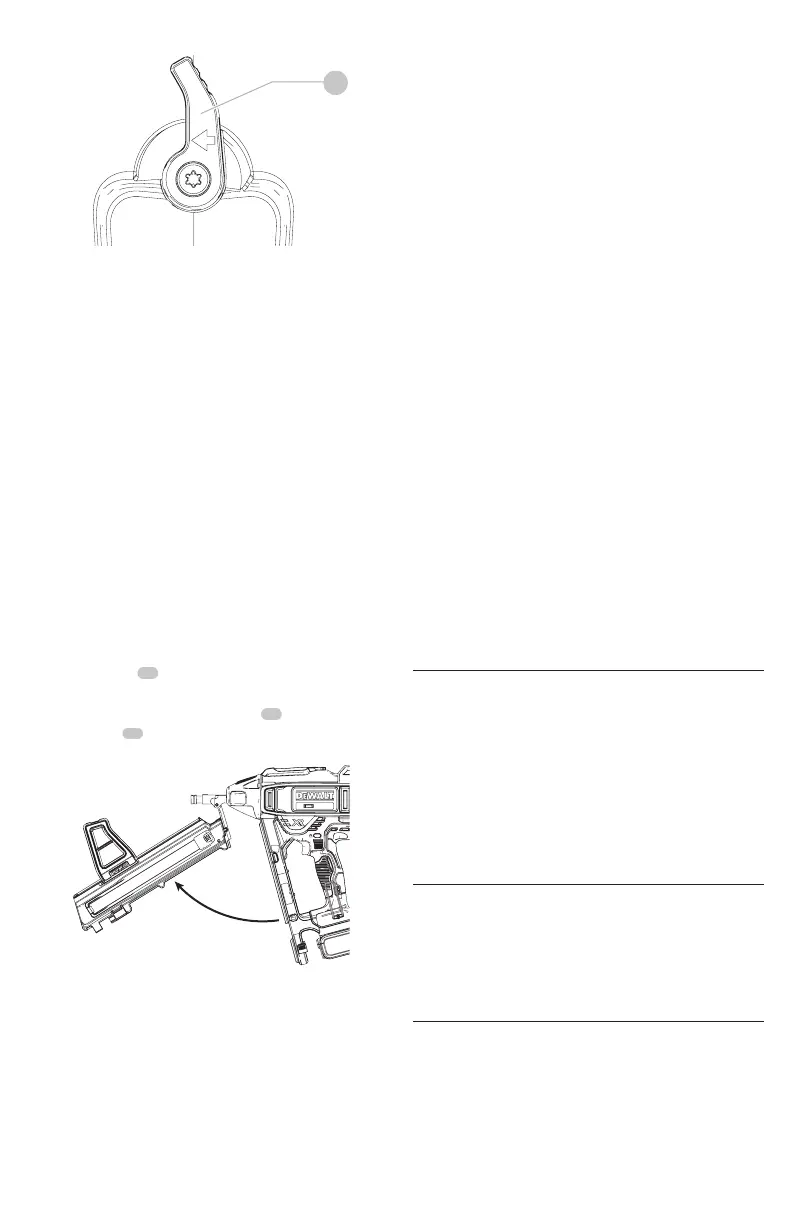ENGLISH
13
Fig. J
8
Clearing a Jammed Pin (Fig. A, K)
WARNING: To reduce the risk of serious personal
injury, disconnect battery pack from tool before
making any adjustments, changing accessories,
servicing, or moving the tool. Such preventative
safety measures reduce the risk of starting the
toolaccidentally.
CAUTION: When removing a jammed pin, DO
NOT orient the nailer with the nose up or with
the battery foot up. Positioning the nailer this way
makes the jammed pin or pieces of the pin more likely
to be ingested into the nailer. If any portion of a pin is
ingested into the tool, the pin should be retrieved by
removing the topcap.
If a pin becomes jammed in the nosepiece, keep the tool
pointed away from you and follow these instructions
toclear:
1. Remove battery pack from tool and engage trigger
lock-off.
2. After laying the tool on its side, slide the spring-loaded
pusher latch
15
to the base of the magazine to lock it
into place and unload pinstrip.
3. Rotate the magazine release lever
14
and rotate the
magazine
12
forward.
Fig. K
4. Remove jammed/bent nail, using pliers if necessary. The
contact trip can be removed if necessary. Refer to To
Replace ContactTrip.
CAUTION: If any portion of a pin is ingested into
the tool, the pin should be retrieved by removing the
topcap.
5. If the driver is in the down position, rotate the stall
release lever on the top of thenailer.
NOTE: If the driver will not reset after rotating the stall
release lever, manually resetting the blade with a long
screw driver may benecessary.
6. Rotate the magazine back into position under the nose
of the tool and close the magazine releaselever.
7. Reinsert batterypack.
NOTE: The tool will disable itself and not reset until the
battery pack has been removed andreinserted.
8. Reinsert pins into magazine (refer to Loading theTool).
9. Release the pusherlatch.
10. Disengage the trigger lock-off when ready to
continuenailing.
NOTE: Should pins jam frequently or the driver continually
fail to reset, have tool serviced by an authorized D
EWALT
servicecenter.
Cold Weather Operation
When operating tools at temperatures below freezing:
1. Keep tool as warm as possible prior touse.
2. Actuate the tool 10 or 15 times into scrap lumber
beforeusing.
Hot Weather Operation
Tool should operate normally. However, keep tool out of
direct sunlight as excessive heat can deteriorate bumpers
and other rubber parts resulting in increasedmaintenance.
MAINTENANCE
WARNING: To reduce the risk of serious personal
injury, turn unit off and remove the battery pack
before making any adjustments or removing/
installing attachments or accessories. An
accidental start-up can causeinjury.
DAILY MAINTENANCE CHART
ACTION Clean magazine, pusher, and contact trip
mechanism.
WHY Permits smooth operation of magazine,
reduces wear, and prevents jams.
HOW Blowing off the tool with compressed air is
the most effective way to clean the tool. The
use of oils, lubricants periodically or solvents
is not recommended as they tend to attract
debris and/or damage the plastic parts of
the tool.
ACTION Before each use, check to ensure all screws
and fasteners are tight and undamaged.
WHY Prevents jams and premature failure of
toolparts.
HOW Tighten loose screws using the appropriate
hex wrench or screwdriver.
Cleaning
WARNING: Blow dirt and dust out of all air vents with
clean, dry air at least once a week. To minimize the risk
of eye injury, always wear ANSI Z87.1 approved eye
protection when performingthis.
WARNING: Never use solvents or other harsh
chemicals for cleaning the non-metallic parts of
the tool. These chemicals may weaken the plastic

